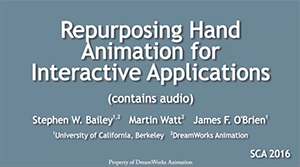Repurposing Hand Animation for Interactive Applications
Abstract
In this paper we describe a method for automatically animating interactive characters based on an existing corpus of key-framed hand-animation. The method learns separate low-dimensional embeddings for subsets of the hand-animation corresponding to different semantic labels. These embeddings use the Gaussian Process Latent Variable Model to map high-dimensional rig control parameters to a three-dimensional latent space. By using a particle model to move within one of these latent spaces, the method can generate novel animations corresponding to the space's semantic label. Bridges link each pose in one latent space that is similar to a pose in another space. Animations corresponding to a transitions between semantic labels are generated by creating animation paths that move though one latent space and traverse a bridge into another. We demonstrate this method by using it to interactively animate a character as it plays a simple game with the user. The character is from a previously produced animated film and the data we use for training is the data that was used to animate the character in the film. The animated motion from the film represents an enormous investment of skillful work. Our method allows this work to be repurposed and reused for interactively animating the familiar character from the film.
Citation
Stpehen W. Bailey, Martin Watt, and James F. O'Brien. "Repurposing Hand Animation for Interactive Applications". In Proceedings of the ACM SIGGRAPH/Eurographics Symposium on Computer Animation, pages 1–10, July 2016.
Supplemental Material










